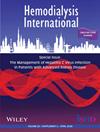Incidence of hyperkalemia in anuric hemodialysis patients treated with sacubitril/valsartan
Abstract
Introduction
Sacubitril/valsartan is increasingly used in hemodialysis patients due to its cardioprotective benefits. However, its impact on serum potassium levels in anuric patients undergoing hemodialysis remains controversial.
Methods
We conducted a retrospective data from patients undergoing hemodialysis at two dialysis centers. A total of 71 out of 332 patients receiving hemodialysis treatment were enrolled. Mean serum potassium (mean value of 6–8 determinations), peak serum potassium (maximum K value observed during follow-up observations), and other biochemical parameters were recorded at baseline and during the follow-up period.
Findings
After 6 months of follow-up, mean serum potassium increased from 4.84 ± 0.45 mmol/L at baseline to 5.07 ± 0.46 mmol/L at 3 months and 5.04 ± 0.46 mmol/L at 6 months (p < 0.001). Notably, no significant group differences were found in peak serum potassium concentrations between baseline and 6 months after sacubitril/valsartan therapy (5.69 ± 0.56 vs. 5.75 ± 0.41, p = 0.419). Prior to starting sacubitril/valsartan treatment, none of the patients had severe hyperkalemia; however, after 3 and 6 months of sacubitril/valsartan therapy, two (2.80%) and three (4.20%) patients experienced severe hyperkalemia, respectively; however, this difference was not statistically significant. Additionally, there was a significant reduction in blood pressure; however, serum sodium, bicarbonate, and Kt/V values did not change significantly during either period.
Discussion
Sacubitril/valsartan therapy is associated with an increase in serum potassium levels in anuric hemodialysis patients. Nevertheless, the proportion of patients with severe hyperkalemia did not increase significantly. This suggests that the use of sacubitril/valsartan in anuric patients on hemodialysis is relatively safe.

 求助内容:
求助内容: 应助结果提醒方式:
应助结果提醒方式:


